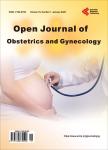Hematological Profile and Risk Factors of Anemia in Pregnant Women: A Cross Sectional Descriptive and Analytical Study in Douala Cameroon
Hematological Profile and Risk Factors of Anemia in Pregnant Women: A Cross Sectional Descriptive and Analytical Study in Douala Cameroon作者机构:Faculty of Medicine and Pharmaceutical Sciences University of Douala Douala Cameroon Department of Obstetrics and Gynecology Laquintine Hospital of Douala Douala Cameroon Faculty of Medicines and Biomedical Sciences University of Yaounde I Yaounde Cameroon Department of Obstetrics and Gynecology University Teaching Hospital Yaounde Yaounde Cameroon Department of Paediatrics Laquintinie Hospital of Douala Douala Cameroon
出 版 物:《Open Journal of Obstetrics and Gynecology》 (妇产科期刊(英文))
年 卷 期:2019年第9卷第7期
页 面:968-980页
学科分类:1002[医学-临床医学] 100214[医学-肿瘤学] 10[医学]
主 题:Hematological Profile Pregnant Women Anemia Risk Factors Cameroon
摘 要:During pregnancy, the hematological system undergoes numerous changes so as to meet up with the demands of the developing fetus and placenta, with major alterations in blood volume and this differs with women from different regions. The aim of this study was therefore to assess the hematological parameters and risk factors for anemia among pregnant women according to different trimesters of pregnancy in Douala, Cameroon. Methods: A cross-sectional study was conducted from February to May 2017, and all pregnant women who attended antenatal visits during our study period and who suited our inclusion criteria were recruited. The study was carried out in the antenatal care Unit of the Douala Laquintinie Hospital (DLH). A pretested questionnaire was used for the necessary data collection. Venous blood was collected from each of these women to perform a Complete Blood Count (CBC) test using an automated hematological analyzer (URIT 3010). Data were analyzed using XLSTAT 2007 and Stata version 11 software. Results: The mean age of the participants was 28 (SD = 5 years). The prevalence of anemia among pregnant women was 22% with a majority (18.4%) of these women being mildly anemic. Mean Hemoglobin values were significantly higher among women in first trimester compared to the third (12.1 ± 0.9 g/dl vs 11.8 ± 1.3 g/dl;p = 0.043). There was also a significant change in mean hematocrit (HCT) values between the first and second trimester (32.8% ± 2.5% vs 31.4% ± 2.9%, p = 0.004) and between the first and third trimester (32.8% ± 2.5% vs 30.8% ± 3.5%, p -4). RBC count value was higher in the first trimester than in the second trimester (3.7 ± 0.3 × 1012/L vs 3.5 ± 0.4 × 1012/L, p -4) and in the third trimester (3.7 ± 0.3 × 1012/L vs 3.5 ± 0.4 × 1012/L, p = 0.001). After a multivariate analysis, the following categories of women had more odds of developing anemia;women between the age range of 30 - 35 (OR = 2.81, 95%CI: 1.16 - 6.81, p = 0.023), women in the second trimester of p




